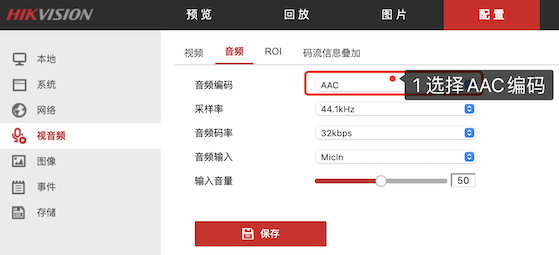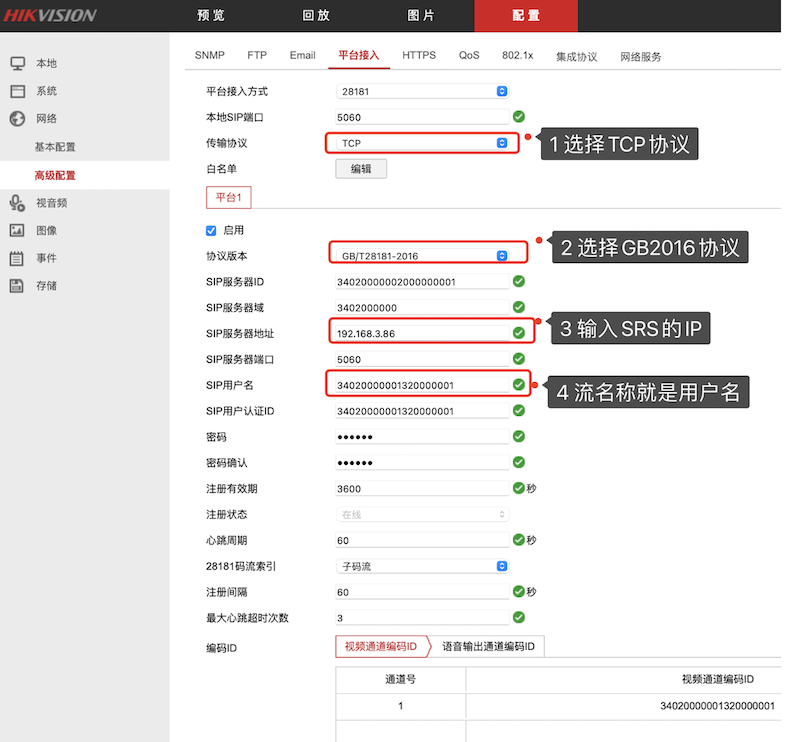Stream Caster
Stream Converter侦听特殊的TCP/UDP端口,接受客户端连接和媒体流,并转成RTMP流,推送给SRS。
简单来说,它将其他流转成RTMP流,工作流如下:
Client ---PUSH--> Stream Converter --RTMP--> SRS --RTMP/FLV/HLS/WebRTC--> Clients
Note: 有些流可能不止一个流,甚至有不同的传输通道。
Use Scenario
常见的应用场景包括:
- Push MPEG-TS over UDP, 通过UDP协议,将裸流MPEGTS推送到SRS,主要是一些编码器支持。
- Push FLV by HTTP POST, 通过HTTP POST,将FLV流推送到SRS,主要是移动端支持。
- Push GB28181 over TCP, 通过TCP协议,将摄像头的流推送到SRS,主要是监控摄像头支持。
Note: FFmpeg支持推送MPEGTS和FLV流到SRS,可以用FFmpeg测试。
Build
SRS默认开启Stream Converter的支持,不需要特别的编译参数。但某些协议可能需要特别的编译参数,请参考下面具体协议的使用介绍。
Protocols
目前Stream Converter支持的协议包括:
- MPEG-TS over UDP: MPEG-TS裸流,基于UDP协议。
- FLV by HTTP POST: FLV流,基于HTTP协议。
- GB28181-2016: SIP和MPEG-PS流,基于TCP协议。
Config
Stream Converter相关的配置如下:
# Push MPEGTS over UDP to SRS.
stream_caster {
# Whether stream converter is enabled.
# Default: off
enabled on;
# The type of stream converter, could be:
# mpegts_over_udp, push MPEG-TS over UDP and convert to RTMP.
caster mpegts_over_udp;
# The output rtmp url.
# For mpegts_over_udp converter, the typically output url:
# rtmp://127.0.0.1/live/livestream
output rtmp://127.0.0.1/live/livestream;
# The listen port for stream converter.
# For mpegts_over_udp converter, listen at udp port. for example, 8935.
listen 8935;
}
# Push FLV by HTTP POST to SRS.
stream_caster {
# Whether stream converter is enabled.
# Default: off
enabled on;
# The type of stream converter, could be:
# flv, push FLV by HTTP POST and convert to RTMP.
caster flv;
# The output rtmp url.
# For flv converter, the typically output url:
# rtmp://127.0.0.1/[app]/[stream]
# For example, POST to url:
# http://127.0.0.1:8936/live/livestream.flv
# Where the [app] is "live" and [stream] is "livestream", output is:
# rtmp://127.0.0.1/live/livestream
output rtmp://127.0.0.1/[app]/[stream];
# The listen port for stream converter.
# For flv converter, listen at tcp port. for example, 8936.
listen 8936;
}
# For GB28181 server, see https://github.com/ossrs/srs/issues/3176
# For SIP specification, see https://www.ietf.org/rfc/rfc3261.html
# For GB28181 2016 spec, see https://openstd.samr.gov.cn/bzgk/gb/newGbInfo?hcno=469659DC56B9B8187671FF08748CEC89
stream_caster {
# Whether stream converter is enabled.
# Default: off
enabled off;
# The type of stream converter, could be:
# gb28181, Push GB28181 stream and convert to RTMP.
caster gb28181;
# The output rtmp url.
# For gb28181 converter, the typically output url:
# rtmp://127.0.0.1/live/[stream]
# The available variables:
# [stream] The video channel codec ID.
output rtmp://127.0.0.1/live/[stream];
# The listen TCP/UDP port for stream converter.
# For gb28181 converter, listen at TCP/UDP port. for example, 9000.
# @remark We always enable bundle for media streams at this port.
listen 9000;
# SIP server for GB28181. Please note that this is only a demonstrated SIP server, please never use it in your
# online production environment. Instead please use [jsip](https://github.com/usnistgov/jsip) and there is a demo
# [srs-sip](https://github.com/ossrs/srs-sip) also base on it.
sip {
# Whether enable embedded SIP server.
# Default: on
enabled on;
# The SIP listen port, for both TCP and UDP protocol.
# Default: 5060
listen 5060;
# The SIP or media transport timeout in seconds.
# Default: 60
timeout 60;
# When media disconnect, the wait time in seconds to re-invite device to publish. During this wait time, device
# might send bye or unregister message(expire is 0), so that we will cancel the re-invite.
# Default: 5
reinvite 5;
# The exposed candidate IPs, response in SDP connection line. It can be:
# * Retrieve server IP automatically, from all network interfaces.
# $CANDIDATE Read the IP from ENV variable, use * if not set.
# x.x.x.x A specified IP address or DNS name, use * if 0.0.0.0.
# Default: *
candidate *;
}
}
下面描述具体协议的使用。
Push MPEG-TS over UDP
你可以推送MPEGTS UDP流到SRS,转换成其他的协议。
首先,使用MPEGTS相关配置启动SRS:
./objs/srs -c conf/push.mpegts.over.udp.conf
Note: 关于详细的配置,请参考Config中
mpegts_over_udp的部分。
然后,使用编码器推流,比如用FFmpeg:
ffmpeg -re -f flv -i doc/source.flv -c copy -f mpegts udp://127.0.0.1:8935
现在,就可以播放流了:
- http://localhost:8080/live/livestream.flv
- http://localhost:8080/live/livestream.m3u8
- http://localhost:1985/rtc/v1/whep/?app=live&stream=livestream
注意MPEGTS UDP是每个端口对应一个具体的RTMP流。
Note: 关于开发的一些细节,请参考#250.
Push HTTP FLV to SRS
你可以推送HTTP FLV流到SRS,对于一些移动端设备,使用HTTP推流会很简单。
首先,使用HTTP FLV相关配置启动SRS:
./objs/srs -c conf/push.flv.conf
Note: 关于详细的配置,请参考Config中
flv的部分。
然后,使用编码器推流,比如用FFmpeg:
ffmpeg -re -f flv -i doc/source.flv -c copy \
-f flv http://127.0.0.1:8936/live/livestream.flv
现在,就可以播放流了:
- http://localhost:8080/live/livestream.flv
- http://localhost:8080/live/livestream.m3u8
- http://localhost:1985/rtc/v1/whep/?app=live&stream=livestream
Note: 关于开发的一些细节,请参考#2611.
Push GB28181 to SRS
GB28181是国内安防摄像头基本都会支持的协议,属于国家标准,主要是摄像头主动连接到服务器的场景。 随着互联网的普及,安防摄像头有时候也需要接入互联网,比如慢直播,或者景区直播等。
Note: 一般安防摄像头的典型场景,是通过RTSP从摄像头拉流,而不是摄像头主动推流,请参考#2304的描述。
再次强调,SRS支持GB协议,其实并不是做安防场景,而只是支持了摄像头上互联网这个比较新也比较小的场景。当然如果有开发能力,也是完全能基于SRS做安防的流媒体服务器。
首先,使用GB28181相关配置启动SRS:
./objs/srs -c conf/gb28181.conf
Note: 关于详细的配置,请参考Config中
gb28181的部分。
然后,配置摄像头推流:


Note: 音频请选择AAC编码,视频选择子码流,传输协议选择TCP,协议版本选择GB28181-2016。
Note: 配置中
CANDIDATE需要配置为摄像头能访问到的IP地址,详细请参考Protocol: GB28181: Candidate。
现在,就可以播放流了,请将设备ID换成你的设备:
- http://localhost:8080/live/34020000001320000001.flv
- http://localhost:8080/live/34020000001320000001.m3u8
- webrtc://localhost/live/34020000001320000001
Note: 关于开发的一些细节,请参考#3176.
Push RTSP to SRS
这个功能已经被删除,详细原因参考#2304。
2015.1
